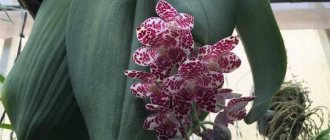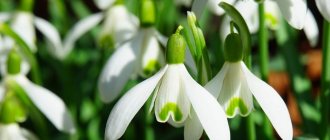Violet (Viola) is a genus of plants in the Violet family (Violaceae). Africa is considered to be its homeland, but the specific location is not known. Most species in their natural environment prefer a moderate, humid climate and are found in the Andes, Japan, North America, New Zealand, Europe, southern Siberia, and Australia. Some varieties prefer subtropical and tropical climates and choose the lands of South Africa and Brazil. Forest violets are found in forest clearings in deciduous forests. The plant chooses open or slightly darkened habitats. In Russia, violet is often called Saintpaulia.
INTERESTING: Violets bloom for 9 - 10 months at any time of the year.
Types of violets
Several types of violets grow in the natural environment: fragrant, marsh, Vittroka (Pansy), field, dog and others. Decorative violets growing in pots vary in variety.
There are a very large number of different varieties of indoor violets.
- Variety Frosty cherry. A plant with double flowers. Interestingly, the older the violet, the darker its flowers become.
- Variety Wedding bouquet. Graceful delicate lush violet flowers, white as a bride's dress. The foliage is light green. They look like a bouquet because the plant produces many stalks of flowers at the same time. This is how the flower earned its name.
- Variety Sea Wolf. Indoor violet with blue star buds.
- Variety Bullfight. A spectacular scarlet or red violet with semi-double, ruffled flowers and green leaves.
- Variety Magic of love. It has some of the largest bright flowers of a star-shaped or wavy shape on low peduncles, blooms very actively. Despite its external beauty and splendor, this violet is also undemanding in care.
- Variety Pauline Viardot. This variety has a variegated rosette, which visually distinguishes this species from other flowers on the windowsill.
- Variety Artik Frost. One of the most unpretentious varieties. It has long flowering. Ideal for beginners. The flower is soft white, variegated with blue splashes.
Successfully used in the interior are ampelous varieties of violets with a border on the petals, a flower in the shape of bells, with light and dark green foliage. Uzambara violet, popular among flower growers, comes in pink, purple, blue and white colors.
German irises: varieties with photos and names
In addition to the pale iris, edible violet species include German and Florentine irises.
German iris is a crop with dense, wide or narrow sword-shaped leaves that persist until autumn. The flowers of these species are large lilac-violet with a colorful bright yellow longitudinal beard, located on long branched peduncles up to 1 m high. German orris blooms in June.
In fact, most types of bearded irises grown in gardens today are derived from the German iris. Pure culture can be seen in botanical gardens, breeding nurseries and experimental sites. In nature it is extremely rare, but on the mountain slopes of Transcarpathia and at the foot of the Himalayas you can still see this plant. In gardens, the leading varieties are those obtained on its basis:
- Summer Night is a tall variety with fragrant bright blue flowers and a bright yellow center.
- Gvardeysky is a particularly fragrant variety with large creamy-yellow inflorescences.
- Baltic Sea is a variety of German iris, with spectacular ruffled blue petals and a deep ultramarine beard.
The German iris is excellent for cutting. The seeds ripen by the end of summer.
Growing violets at home from leaves
Indoor violets cannot be called difficult to care for plants, but you need to know some of the nuances of growing depending on the type of flower. If you take into account the preferences and characteristics of the plant, it will delight you with beautiful flowers and a healthy appearance for a long time.
Petiole trimming
Often at home, violets are grown from leaves. A baby will be produced from it. The first step is to carefully trim the petiole to propagate the flower. For these purposes, use sharp, disinfected scissors.
Where to get a leaf
A leaf is selected from an adult plant in the second or third row of the rosette. Violet or Saintpaulia pruning is carried out in the spring at the beginning of the growing season.
Preparing the container and soil
The soil for violets should not be too nutritious, loose with good air permeability. For loosening, you can use vermiculite, dry sphagnum and even crushed foam.
Violets need a low but wide pot, since the root system grows mainly in width. Plastic containers work well; the plant’s roots will not catch on this material.
Rooting in water
To root violets in water, select a small container and sterilize it. Take filtered water and dissolve an activated carbon tablet. Coal will become an adsorbent for mucus and sediment.
It is important that the flower stalk in the water does not touch the walls of the container. To do this, long violet cuttings are secured using cardboard or thick paper with a slot placed on the edges of the container. A violet stalk is placed in a slot that is sufficient for the thickness of the stem of the flower leaf, but prevents the entire leaf from falling into the water.
During the entire period of violet germination, they monitor the cleanliness and transparency of the water and the condition of the leaf - it should not rot or become stained.
After the roots appear, you need to wait until the bud begins to grow, then you can transfer the leaf.
Rooting in soil
When propagating violets, each leaf is planted in a separate plastic cup. A hole is made at the bottom of the cup to drain excess moisture, drainage is poured, and soil is placed on top of it just below the edge of the container. The leaf stalk is deepened by 1-2 cm. It is important that the violet leaf does not touch the ground; to do this, it can be supported with a match. The glass with flower seedlings is covered with a bag or a larger plastic glass to maintain the desired temperature until roots appear.
Important. You can replant violet or Saintpaulia when the new grown leaves of the plant have reached a diameter of 2-3 centimeters.
Iris: a plant with a history
Cultivated since time immemorial, the iris is a symbol of trust, loyal friendship and deep affection among many peoples. It is also mentioned in ancient epics and medical treatises, since iris has long been known not only as an ornamental flower, but also as a valuable essential oil crop, as evidenced by its elegant name “orris root”.
There are about hundreds of similar species. Almost all of them are herbaceous rhizomatous perennials, distributed in almost all parts of the world, with the exception of the permafrost pole.
Conditions for keeping violets
Indoor violets are heat-loving flowers; in order for them to bloom magnificently and delight with their beauty, certain conditions must be observed.
Location
Violets do not like drafts and direct sunlight. Flowers feel great on windows with diffused sunlight during the day, for example on the east side.
Temperature
For good growth of violets, a temperature of about 24°C in summer and slightly lower in winter is suitable. If the temperature is always below 16-18°C, the plants will not bloom.
Humidity
High air humidity is favorable for violets, but moisture on the leaves and flowers is harmful. Violets are not sprayed and Saintpaulias are watered very carefully.
The soil
Violets prefer loose, breathable soil with low acidity. It may include coniferous soil, leaf soil, a little peat and sand. The easiest option is to choose a ready-made mixture for violets. In this case, fertilizers will not be needed soon.
Pot
From the point of view of aesthetics and the shape of the root system, violets or Saintpaulias should choose low and wide containers. The plant looks harmonious in them, and care in such containers is not difficult.
Description
The pale iris (orris root) is an ornamental and at the same time medicinal plant with a characteristic yellowish-brown, creeping, fleshy rhizome with a dense starchy structure. The unpretentiousness of the plant allows it to be grown in any region of our country, but it is almost never found growing wild. Orris root is cultivated in gardens, pursuing two purposes - decorating the estate space and using it for medicinal purposes. The rhizome contains unique chemical compounds that have healing properties. The iris root, growing, gradually dies from below, forming young branches that annually form leaves and peduncles.
How to care for violets at home
Caring for violets will not be a hassle; you just need to take into account the peculiarities of watering the plants.
Methods of watering violets
Violets are harmed by moisture on green leaves and flowers, so the methods of watering these plants differ from the usual methods.
Watering through a tray
Clean water is poured into the pan. Through the hole, moisture passes into the ground, and the violet receives the required volume of liquid. If desired, fertilizers are added to the water.
Drip irrigation
For compact indoor violets, drip watering can be used. To do this, use a syringe. The narrow nose of the syringe is brought directly to the soil with the plant, without touching the green leaves and flowers of Saintpaulia, and without eroding the roots of the violet.
Immersion method
For this method, take a container wider than the pot and fill it with water. The container with the plant is immersed in a container. After 15-20 minutes, the flower can be put back in place and the remaining water can be poured out.
Wick watering
Wick watering is convenient for violets when you need to go away and leave the plants alone for a while. Organizing this procedure is not at all difficult. A wick - natural or nylon rope - is placed in the drainage holes. The other part of the Saintpaulia remains outside and is immersed in a container of water, on which the container is placed above.
Top dressing
Throughout the season, violets are fertilized with nitrogen-containing fertilizers, 3-4 times is enough. To maintain and increase the number of flowers, phosphorus-potassium fertilizers in dry or liquid form are added to the fertilizing.
Trimming
Trim off wilted, yellow, diseased violet leaves with signs of rot. Pruning is also carried out in order to reduce the number of leaves and achieve flowering faster. For pruning, use a disinfected sharp knife. It is recommended to cut as close to the violet stem as possible, and treat the cut area with charcoal. Pruning in combination with fertilizers enhances flowering.
Important. If the Saintpaulia stem is too bare, you need to add soil.
Hygiene
The velvety leaves of violets do not react well to water, but they still need to be cleaned of dust and soil. To do this, use a soft brush, using it like a broom, the main thing is to carefully sweep away everything unnecessary from the plant’s rosette. After flowering, it is better to remove the flower stalks.
Wintering
Plants overwinter in the apartment, but not on the balcony. The favorable temperature range for violets is 18-24°C. If the flowers are on the windowsill, you need to make sure that the heat from the heating devices and the cold from the window do not mix next to the violets. It would be ideal to place the shelving close to the window, but not in a draft or at the temperature limit.
Features of culture
Iris is a winter-hardy plant, resistant to short-term droughts and not demanding on the composition of the soil. However, luxurious flowering can be achieved from it if you create the most comfortable conditions. For example, it should be taken into account that iris are very light-loving. Therefore, well-lit areas for the crop are chosen, and the soil is carefully dug up before planting, adding humus and mineral fertilizers.
Iris rhizomes are an excellent planting material necessary for vegetative propagation. For this purpose, pieces of rhizomes or their shoots with formed growth buds are used.
Transplanting violets at home
For this, two methods are used: the transshipment method and soil replacement.
Transplantation by transshipment method
This method is used for specimens with an overgrown root system. The soil is well moistened. Prepare a larger container with drainage and a small amount of soil. The violet is removed from its previous place along with the earthen lump and the rosette is carefully placed in the new place, soil in the upper tier is added, and watered. Fertilizers can be used after a couple of weeks or at the beginning of flowering.
Replanting with soil replacement
The method is similar to the previous one, but the main difference is that the earthen ball is not stored on the roots of the plant. If possible, carefully untangle the soil and roots of the violet, shake off the remaining soil and transfer the plant as a whole rosette to a new place with new soil.
Pests and diseases of violets
Violets are attacked by many pests: various mites, aphids, mealybugs, whiteflies, springtails and others. Delicate violets are also susceptible to many diseases. Some of them are: powdery mildew, rust, root and stem rot. Diseases that are fungal in nature are more difficult to defeat.
Prevention of violet diseases can include sterilization of the soil, compliance with maintenance conditions, not reusing soil from other plants, regular fertilization and flowering control. For any signs of disease on the leaves or petals, medications are selected. You can apply them under the roots or on the leaves of the violet.











